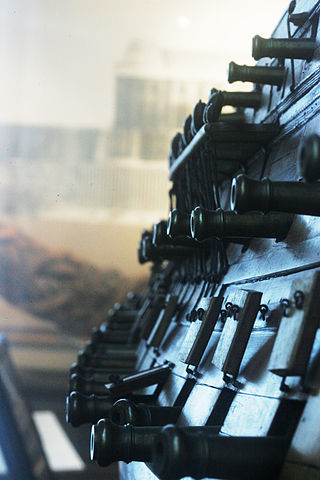
A broadside is the side of a ship, or more specifically the battery of cannon on one side of a warship or their coordinated fire in naval warfare, or a measurement of a warship's maximum simultaneous firepower which can be delivered upon a single target. From the 16th century until the early decades of the steamship, vessels had rows of guns set in each side of the hull. Firing all guns on one side of the ship became known as a "broadside". The cannon of 18th-century men of war were accurate only at short range, and their penetrating power mediocre, which meant that the thick hulls of wooden ships could only be pierced at short ranges. These wooden ships sailed closer and closer towards each other until cannon fire would be effective. Each tried to be the first to fire a broadside, often giving one party a decisive headstart in the battle when it crippled the other ship.

USS Iowa was a pre-dreadnought battleship built for the United States Navy in the mid-1890s. The ship was a marked improvement over the previous Indiana-class battleships, correcting many of the defects in the design of those vessels. Among the most important improvements were significantly better seaworthiness owing to her greater freeboard and a more efficient arrangement of the armament. Iowa was designed to operate on the high seas, which had been the impetus to increase the freeboard. She was armed with a battery of four 12-inch (305 mm) guns in two twin-gun turrets, supported by a secondary battery of eight 8-inch (203 mm) guns.

An ironclad is a steam-propelled warship protected by iron or steel armor plates, constructed from 1859 to the early 1890s. The ironclad was developed as a result of the vulnerability of wooden warships to explosive or incendiary shells. The first ironclad battleship, Gloire, was launched by the French Navy in November 1859 - narrowly pre-empting the British Royal Navy.
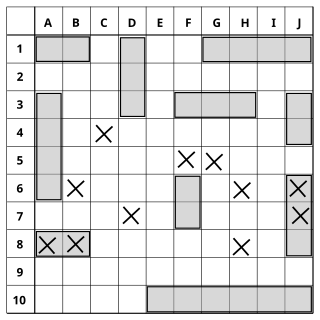
Battleship is a strategy type guessing game for two players. It is played on ruled grids on which each player's fleet of warships are marked. The locations of the fleets are concealed from the other player. Players alternate turns calling "shots" at the other player's ships, and the objective of the game is to destroy the opposing player's fleet.
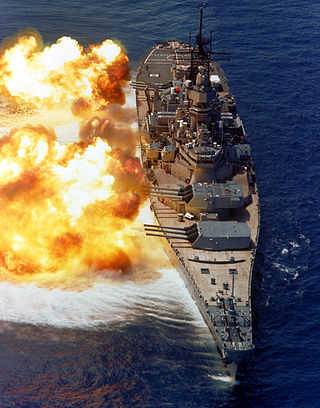
The 16"/50 caliber Mark 7 – United States Naval Gun is the main armament of the Iowa-class battleships and was the planned main armament of the cancelled Montana-class battleship.

The Colorado-class battleships were a group of four United States Navy super-dreadnoughts, the last of its pre-Treaty battleships. Designed during World War I, their construction overlapped the end of that conflict and continued in its immediate aftermath. Though all four keels were laid, only three ships entered service: Colorado, Maryland, and West Virginia. Washington was over 75% completed when she was canceled under the terms of the Washington Naval Treaty in 1922. As such, the 16" gun Colorado-class ships were the last and most powerful battleships built by the U.S. Navy until the North Carolina class entered service on the eve of World War II.
Battlefleet Gothic is a miniature wargame that was produced by Games Workshop from 1999 to 2013. It simulates combat between large spaceships. It was developed primarily by Andy Chambers. Although this miniature wargame is no longer supported by Games Workshop, two video game adaptations have been made since its cancellation.

The Colossus-class battleships were a pair of dreadnought battleships built for the Royal Navy (RN) at the end of the first decade of the 20th century, the last 12-inch-gunned (305 mm) battleships built for the RN. The sister ships spent their whole careers assigned to the Home and Grand Fleets, often serving as flagships. Aside from participating in the Battle of Jutland in May 1916, and the inconclusive action of 19 August several months later, their service during the First World War generally consisted of routine patrols and training in the North Sea.

Full Thrust is a science fiction strategy wargame written by Jon Tuffley and published by Ground Zero Games of England. It is usually played with miniature figurines representing imaginary starships, although cardboard chits representing the vessels can also be used. Unlike many games, the publishers encourage the use of any miniatures rather than only "official" ones, though Ground Zero Games does also sell an extensive miniature range.

Space Crusade is an adventure board game produced by Milton Bradley together with Games Workshop and was first made in 1990. It was produced in the UK and available in some other countries including Finland, Ireland, France, Spain, Denmark, Australia and New Zealand. In Germany, Italy, Belgium and the Netherlands, it is known as Star Quest.

Naval artillery is artillery mounted on a warship, originally used only for naval warfare and then subsequently used for more specialized roles in surface warfare such as naval gunfire support (NGFS) and anti-aircraft warfare (AAW) engagements. The term generally refers to tube-launched projectile-firing weapons and excludes self-propelled projectiles such as torpedoes, rockets, and missiles and those simply dropped overboard such as depth charges and naval mines.

A salvo is the simultaneous discharge of artillery or firearms including the firing of guns either to hit a target or to perform a salute. As a tactic in warfare, the intent is to cripple an enemy in one blow and prevent them from fighting back.
The development of the steam ironclad firing explosive shells in the mid-19th century rendered sailing ship tactics obsolete.

HMS Hercules was a central-battery ironclad of the Royal Navy in the Victorian era, and was the first warship to mount a main armament of 10-inch (250 mm) calibre guns.
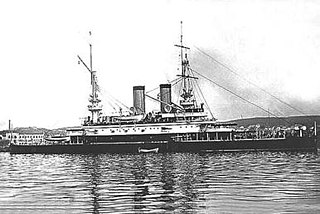
Tri Sviatitelia was a pre-dreadnought battleship built for the Imperial Russian Navy during the 1890s. She served with the Black Sea Fleet and was flagship of the forces pursuing the mutinous battleship Potemkin in June 1905. During World War I the ship encountered the German battlecruiser SMS Goeben twice, but never hit the German ship, nor was she damaged by her. From 1915 onward she was relegated to the coast bombardment role as she was the oldest battleship in the fleet. Tri Sviatitelia was refitting in Sevastopol when the February Revolution of 1917 began and she was never operational afterwards.

The Imperator Aleksandr II-class battleships were two battleships built for the Imperial Russian Navy in the 1880s. They were intended to counter the small armored ships of the other Baltic powers. Construction was very prolonged and the ships were virtually obsolescent when completed. They were optimized for ramming.

HMS Inflexible was a Victorian ironclad battleship carrying her main armament in centrally placed turrets. The ship was constructed in the 1870s for the Royal Navy to oppose the perceived growing threat from the Italian Regia Marina in the Mediterranean.
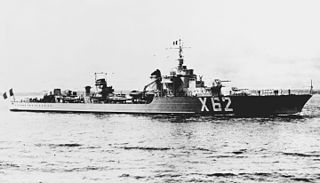
The Mogador-class large destroyers (contre-torpilleurs) of the French Navy were laid down in 1935 and commissioned in 1939. They were extremely fast, very large destroyers intended to act as scouts for the two fast Dunkerque-class battleships. The design evolved from the extremely fast Le Fantasque class, being 300 tons heavier and carrying eight guns in semi-enclosed twin turrets rather than five guns in single open mounts. With their eight 138.6 mm (5.46 in) guns they approached a light cruiser in firepower.

The Nassau class was a group of four dreadnought battleships built for the German Kaiserliche Marine in the early 1900s. The class comprised Nassau, the lead ship, Rheinland, Posen, and Westfalen. All four ships were laid down in mid-1907, and completed by late 1910. Though commonly perceived as having been built in response to the British Dreadnought, their design traces its origin to 1903; they were in fact a response to Dreadnought's predecessors of the Lord Nelson class. The Nassaus adopted a main battery of twelve 28 cm (11 in) guns in six twin-gun turrets in an unusual hexagonal arrangement. Unlike many other dreadnoughts, the Nassau-class ships retained triple-expansion steam engines instead of more powerful steam turbines.
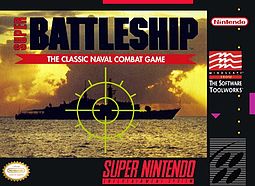
Super Battleship is a naval simulator video game released for the Genesis and Super NES in 1993. The game is strictly single-player and is primarily a strategy game with some real-time elements. It is based on the Battleship board game by the Milton Bradley Company.


















